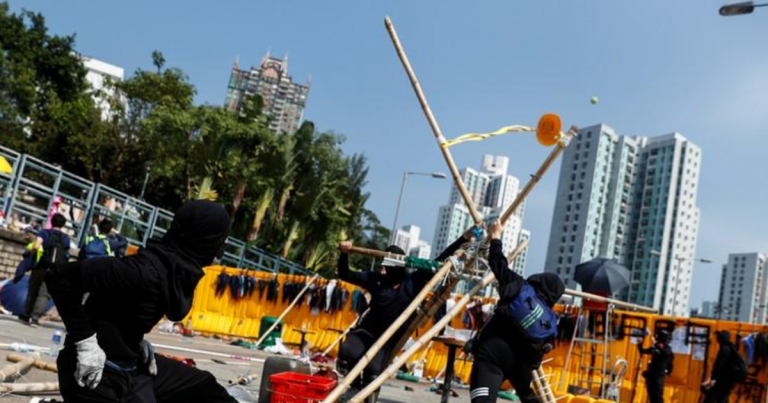
HONG KONG (Reuters) – Anti-government protesters paralyzed parts of Hong Kong for a fourth day on Thursday, forcing school closures and blocking highways and other transport links to disrupt the financial hub amid a marked escalation of violence.
Protesters have torched vehicles and buildings, hurled petrol bombs at police stations and trains and vandalized prime shopping malls over the past week in some of the worst violence seen in more than five months of unrest.
Hundreds of protesters occupied roads in the Central business district, home to some of the world’s most expensive real estate, during their lunch hour.
Many were dressed in office attire and wore the now-banned face masks as they marched down a major thoroughfare that connects luxury shopping malls and glittering skyscrapers.
Hundreds of protesters also set up barricades near a popular shopping mall in the eastern part of Hong Kong island, dragging traffic cones and orange gates to block roads.
Some held up signs reading “Liberate Hong Kong, revolution of our time” and “Stand with Hong Kong”, slogans that have become rallying calls for the protest movement.
Across the harbor, black-clad protesters and university students maintained their blockades of major roads, including the entrance to the Cross-Harbour Tunnel that links Hong Kong island to the Kowloon area, and a highway between Kowloon and the rural New Territories.
Police fired tear gas near the tunnel early on Thursday to try to clear the protesters. Roads were strewn with bricks and other debris, leading to widespread traffic jams.
Thousands of students barricaded themselves inside campuses at several universities overnight, preparing stockpiles of food, bricks, petrol bombs and other make-do weapons as they hunkered down.
Dozens of riot police gathered outside several universities early on Thursday as students fortified their positions with metal poles, bricks and chairs.
At Hong Kong’s Polytechnic University, near the Kowloon entrance of the Cross Harbour tunnel, hundreds of students wearing gas masks readied for confrontations with police.
Boxes of petrol bombs were placed at vantage points overlooking roads including the tunnel, which has been blocked since Wednesday evening.
Students also poured liters of cooking oil across the ground in an attempt to thwart police should they try to enter.
Masses of commuters queued at metro stations across the city after some rail services were suspended and roads closed. Some people, dressed in office wear, shouted at riot police who were deployed on station platforms.
GROWING ANGER
The demonstrations were initially spurred by what many residents see as the stifling of freedoms guaranteed under a “one country, two systems” formula put in place when the territory returned to Chinese rule in 1997.
In particular, people were alarmed by a proposed law, now dropped, that would have seen criminal suspects liable to prosecution in mainland courts. Anger grew about what many see as police brutality as the protests intensified.
China denies interfering and has blamed Western countries, including Britain and the United States, for stirring up trouble. Police deny using excessive force.
Police said on Wednesday violence had reached a “very dangerous and even deadly level”.
Authorities said 64 people were injured during Wednesday’s clashes, which left two men in critical condition. There were no further details about their injuries.
Police said a man had died after falling from a height on Wednesday but gave no further details.
Hong Kong’s embattled leader, Carrie Lam, met senior officials late on Wednesday, media reported, amid speculation of new emergency measures to deal with the crisis.
“The government and the police have escalated the violence,” said a 24-year-old worker caught in the traffic gridlock who gave her name as Kristy.
“If the government wants the violence to stop they need to listen to our demands,” she said.
The city’s Education Bureau announced on Thursday that all schools would be shut through the week due to safety concerns, which usually only happens during typhoons.
Several universities also announced there would be no classes on campuses for the rest of the year, while several shopping malls said they would close on Thursday.
BOTH SIDES ‘AT FAULT’
Lam said this week protesters paralyzing the city were “selfish” and were now the people’s enemy.
While protests have usually taken place on weekends, with the city getting back to business during the week, the demonstrations are now taking place on week days, bringing huge disruption to the city of 7.4 million.
Pinky Lau, a 29-year-old finance executive who was among hundreds of people waiting for a train at a station in the government district, said protesters were disrupting transport because the government was not listening.
“I’m hoping that the government will become a real government – a government that can help its citizens and listen to them,” she said.
Hong Kong’s metro operator MTR Corp said several train lines, stations and bus routes would remain shut due to damaged facilities, with the whole network shutting by 10 p.m. (1400 GMT), more than two hours early.
The early closures and termination of transport services has further weakened the city’s economy, which fell into recession for the first time in a decade in the third quarter. Retail and tourism have been hit hard by a fall in visitor numbers.
“Both sides play a role in creating this result,” an office worker surnamed Chan said as she waited for a train to get to work.
She said she had initially supported the protesters but they had now gone too far.
“I hope things will return to normal as soon as possible.”





